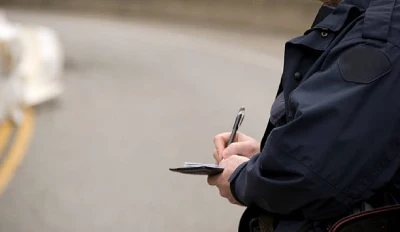Recording and Reporting Hazards Effectively
Why Recording and Reporting Matters
As a security officer, you are often the first person to identify hazards on-site — from a wet floor in a reception area to a damaged stair rail in a car park. Spotting these hazards is only the first step. To keep people safe and stay compliant with industry expectations, you must also record and report hazards properly.
This process isn’t just “ticking a box.” It’s about:

Protecting people – preventing slips, trips, and falls before they happen.
Fulfilling your duty of care – as expected under the Health and Safety at Work Act 1974 and industry standards like SIA, HSE, BSI, and NSI guidance.
Protecting yourself and your employer – if an incident occurs, your report is the evidence that you acted responsibly and professionally.
Remember: If it’s not recorded, in the eyes of the law and your employer, it didn’t happen.
What to Record
When you spot a hazard, your report should answer these key questions:
What is the hazard?
Be specific: “Spillage of water on tiled floor by entrance” is clearer than “wet floor.”
Where is it?
Exact location: “Main entrance lobby, next to reception desk.”
When did you see it?
Date and time of discovery.
What actions did you take?
For example: Placed warning cone, radioed cleaning staff, informed site manager.
Who else was informed?
Note who you reported it to — supervisor, control room, facilities team, etc.
How to Report
Depending on your site, you might use:
Incident report forms – written or digital.
Daily occurrence books (DOBs) – the official security log.
Radio/phone reports – immediate communication, followed by written confirmation.
Internal safety systems – some sites use apps or reporting portals.
Tip: Always write reports in clear, professional language. Avoid slang or assumptions. Stick to facts.
Real-World Example
Scenario: During a night patrol, you notice water dripping from a ceiling into a busy stairwell.
Action Taken: You cordon off the affected area with hazard tape, place a wet floor sign, and inform facilities.
Report Logged:
Hazard: Water leak on stairwell creating slip risk.
Location: East stairwell, Level 2.
Time: 02:15.
Action: Isolated area, warning signage, facilities notified.
If an accident had occurred later, your accurate report shows you acted responsibly and in line with expectations.
Tips for Effective Recording and Reporting
Be precise, not vague – detail matters.
Act first, then report – make the area safe before paperwork.
Keep it professional – reports may be read in court or by insurers.
Log quickly – the sooner you report, the fresher the details.
Use plain English – anyone reading your report should understand it easily.
Common Barriers to Reporting (and How to Overcome Them)
Even experienced officers sometimes fail to report hazards properly. Here are the most common reasons — and how to avoid them:
“I’m too busy.”
Reality: A quick note in the DOB or app takes less than a minute. Not reporting could cost hours of investigation after an accident.
“It’s only a small hazard.”
Reality: Even minor hazards can cause serious accidents. A “small spill” can send someone to hospital.
“Someone else will deal with it.”
Reality: You may be the only person who spotted it. Always assume it’s your responsibility until you’ve logged it.
Pro Tip: Think of reporting as part of the patrol itself, not as “extra paperwork.”
Statistics Worth Knowing
Slips, trips and falls are the most common workplace accident in the UK, accounting for over 30% of all reported injuries (HSE).
Many claims fail or succeed based on the quality of hazard reporting records kept by staff.
Your reports are not just admin — they’re legal protection for everyone involved.
Consequences of Poor Reporting
Failing to record and report hazards properly might not seem serious in the moment — but the effects can be immediate, long-lasting, and very costly. Let’s break it down:
For Staff and Visitors
If a hazard goes unreported, someone could slip, trip, or fall where you had the chance to act.
A wet floor with no warning sign can send a visitor to A&E.
A loose carpet tile might cause an elderly person to fall and suffer a broken hip.
These are not just accidents — they’re preventable injuries that your report could have stopped.
For the Business
Every missed report puts the company at risk.
Legal claims: Injured people may take the business to court.
Financial losses: Compensation and fines can run into thousands of pounds.
Reputation damage: One viral news story about “unsafe premises” can lose client trust overnight.
A single overlooked hazard could undo years of building a strong reputation.
For You as a Security Officer
This is personal. Poor reporting reflects directly on your professionalism.
If negligence is proven, your SIA licence could be at risk.
It may affect your employment record and chances of future work.
At the very least, it damages the trust your employer and colleagues place in you.
Your report is your shield — without it, you may be left exposed if something goes wrong.
Good vs Poor Reporting: Example Comparison
To understand what “effective reporting” looks like, compare these two versions of recording the same hazard:
| Poor Reporting | Good Reporting |
|---|---|
| “Wet floor seen in corridor. Told cleaner.” | “At 11:20, noticed water spillage in the south corridor near exit doors. Placed wet floor cone to prevent access, notified cleaning team at 11:22, and updated control room. Area safe by 11:30.” |
See the difference?
The poor report is vague, lacks detail, and could be challenged if an incident occurs.
The good report is clear, timed, location-specific, and shows exactly what actions were taken.
Result: In the event of a claim or investigation, the detailed version will stand up to scrutiny — the vague one will not.
Scenario for Practice
You’re patrolling a shopping centre and notice that cleaning staff have left buckets and mops unattended in a busy walkway.
What details would you include in your report?
Who would you notify first?
What immediate actions could you take?
(Think it through before moving on.)

